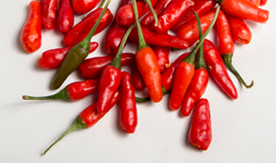Turning Down The Heat

A new pepper variety has been developed with a high capsinoid content to make it less pungent while maintaining all the natural health benefits of the fruit, according to researchers with the U.S. Department of Agriculture and the University of Maine.
The researchers — Robert Jarret from the USDA/Agricultural Research Service in Griffin, Georgia, and Jason Bolton and L. Brian Perkins from the University of Maine School of Food and Agriculture — developed the new small-fruited Capsicum annuum L. pepper through traditional breeding methods in an effort to make the health benefits of hot peppers available to more consumers.
In hot peppers, capsaicinoids are the compounds associated both with their signature heat and health benefits, which include being a source of antioxidants. But that pungency can limit their use in foods and pharmaceuticals.
Capsinoids, closely related compounds of capsaicinoids, provide the same benefits without the pungency.
Starting in 2006 with a USDA seed grant, Perkins, a UMaine assistant research professor and director of the Food Chemical Safety Laboratory, and Bolton, then a food science graduate student, screened about 500 subspecies of Capsicum annuum. They forwarded their data to Jarret, who selected those with the highest concentrations of capsinoids.
Jarret then began to classically breed the selected varieties at the USDA facility in Georgia. Perkins screened the results and they repeated the process, selecting the best capsinoid producers from each generation.
The culmination of their work is germplasm 509-45-1. The peppers are very small, with each plant producing up to 1,000 peppers. According to Perkins, there will likely be additional selection to prepare the plants for marketability, both as a food product and for medical experiments.
Currently, small quantities of seed are available from the USDA for research purposes.
Contact: Margaret Nagle, 207.581.3745
